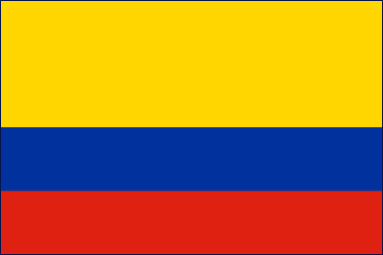
The three horizontal stripes that make up the Colombian flag are yellow on top, blue in the middle, and red on the bottom. The color yellow stands in for all the gold that has ever been discovered in Colombian soil.
The Caribbean Sea and the Pacific Ocean, which the country’s north and west are bordered by, are represented by the color blue. Furthermore, in Colombian culture, blue stands for the equality of all races and social strata. Red represents the blood shed by the heroes of the national freedom movement as well as their sacrifices as martyrs.
Christopher Columbus’s expedition’s flag served as an inspiration for the flag’s design.
Fact about Colombia flag |
|---|
| Country | Colombia |
|---|---|
| Designed by | NA |
| Adopted | November 26, 1861 |
| Revision | NA |
| Design and Colors | A triband flag with horizontal bands colored yellow, blue and red. Vertically the yellow occupies 50% and the other 50% is shared by the blue and red colours. |
| Size Ratio | 2:3 |
| Official Name: | The Republic of Colombia |
| Flag Proportion: | 2:3 |
| Adopted on: | November 26, 1861 |
| Location of Colombia: | Northwestern South America, bordered by Panama, Caribbean Sea, Venezuela, Brazil, Ecuador, Peru, and the Pacific Ocean |
| Capital City: | Santa Fe de Bogota |
| Major Cities: | Medellin, Santa Marta, Monteria, Armenia |
| Area: | 440,831 square miles |
| Population: | 46,366,364 |
| Currency: | Peso (COP) |
| Official Language: | Spanish |
| National Anthem: | O unfading glory! |
| National symbol(s): | Andean condor |
| National colors: | yellow, blue, red |
| National anthem: | |
| Name: | “Himno Nacional de la Republica de Colombia” (National Anthem of the Republic of Colombia) |
| Lyrics/Music: | Rafael NUNEZ/Oreste SINDICI |
Historical Background
The current design of the Colombian flag was officially adopted on November 26, 1861, during the period of Gran Colombia, which was a federation of several South American countries. After Gran Colombia dissolved, Colombia retained the flag as a symbol of its independent identity.
Design and Colors
The Colombian flag consists of three horizontal bands of equal width. From top to bottom, the colors are yellow, blue, and red.
Symbolism of the Colombian Flag
The yellow color represents the riches and resources of Colombia, including its natural wealth and the sun that shines over the nation. The blue color represents the two oceans that border Colombia, the Atlantic and Pacific, as well as the country’s desire for peace and tranquility. The red color symbolizes the bloodshed and sacrifices made by the Colombian people in their struggle for independence and freedom.
Colombian Independence Day
Colombian Independence Day is celebrated on July 20th each year, commemorating the day in 1810 when Colombia began its fight for independence from Spanish colonial rule. This day is marked by various celebrations, parades, and flag-raising ceremonies, showcasing the importance of the Colombian flag as a symbol of independence and national identity.
FAQs
Q1: When was the current design of the Colombian flag adopted?
The current design of the Colombian flag was officially adopted on November 26, 1861, during the period of Gran Colombia.
Q2: What do the colors on the Colombian flag represent?
The yellow color represents the riches and resources of Colombia, including its natural wealth and the sun that shines over the nation. The blue color represents the two oceans that border Colombia and the country’s desire for peace and tranquility. The red color symbolizes the bloodshed and sacrifices made by the Colombian people in their struggle for independence and freedom.
Q3: What is Colombian Independence Day?
Colombian Independence Day is celebrated on July 20th each year
Q4: What is the significance of the two oceans represented by the blue color on the Colombian flag?
The blue color on the Colombian flag represents the two oceans that border Colombia, the Atlantic and Pacific. It symbolizes Colombia’s unique geographical location and its strong connection to both the Caribbean Sea and the Pacific Ocean. Additionally, the blue color represents the country’s aspiration for peace and tranquility.

